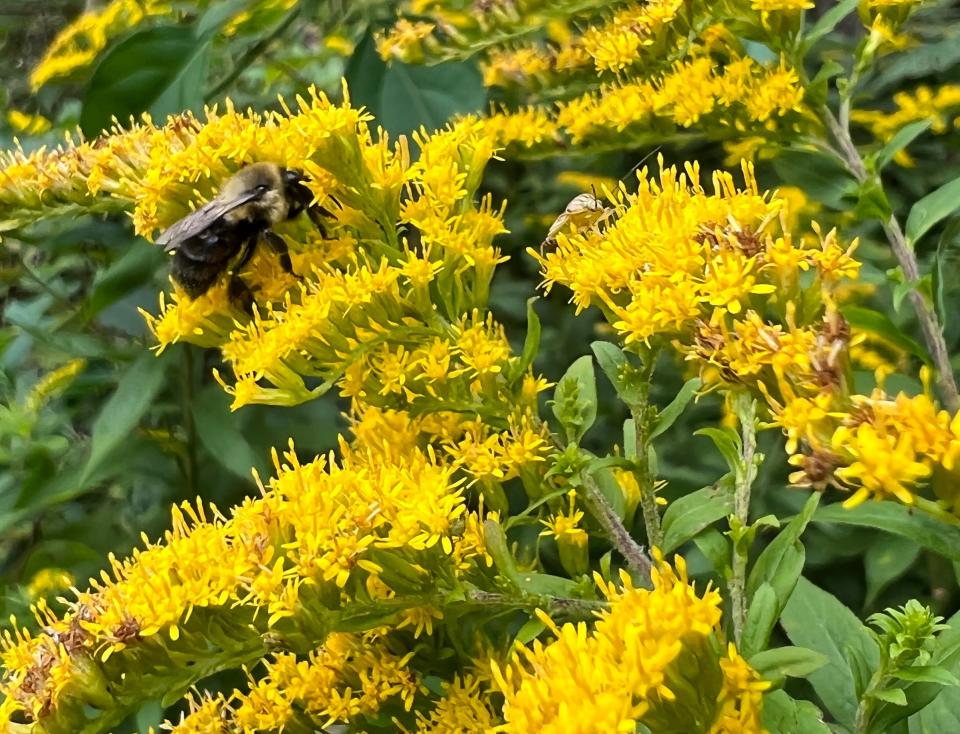Welcome the goldenrod this fall instead of fearing it. It's not what's making you sneeze.
One of my biggest light-bulb-going-off moments has to do with goldenrod. I’ve always had seasonal allergies and for a big chunk of my life blamed goldenrod. Then, perhaps ten years ago, I learned that goldenrod isn’t the culprit. It isn’t wind-pollinated so doesn’t actively release pollen into the atmosphere. Conifers and ragweed and grasses are to blame.

The reason this fun fact about goldenrod was such an eye-opener for me was that it is one of those things that is so obvious in retrospect, so obvious once you really think about allergies and what causes them.
Showy flowers rely on insects, hummingbirds and other pollinators, not wind, to transfer pollen (the allergen in question) from flower to flower. Conifers (pine, spruce and fir) belong to an ancient group of plants called gymnosperms that evolved before the flowering plants (angiosperms). They don’t produce flowers, but rather rely on the release of often huge amounts of very light-weight pollen for fertilization of their eggs. The hemlocks in my neighborhood released so much pollen at one point that visibility was reduced to just a couple feet and our cars were completely covered with their bright yellow pollen.
Commentary: New Hampshire’s 1970s-era energy policy is costing Granite Staters
Ragweed is probably the biggest airborne pollen producer right now. The ragweed in my neighborhood is currently topped with long green spikes — the flowers — and if you shake those flowers, they release pollen. One plant can produce more than one billion grains of pollen per season (around one million pollen grains per day!), and that pollen is one of the most allergenic of all pollen.
While most of the pollen falls close to the source, it has been found in the air 400 miles out to sea and two miles up in the atmosphere! Unlike the conifers, ragweed is a flowering plant (an angiosperm) as are grasses. You can assume that they are wind-pollinated because their flowers are not very showy. But, this isn’t always the case. There are plenty of tiny flowers pollinated by insects out there.
Goldenrod, for example, has small, but beautiful composite (like a daisy) flowers. Why would a plant put energy into producing a colorful flower if not to attract pollinators? That is almost always what those colors are for. So, when you see a colorful flower you can make the generalization that it is probably pollinated by an insect, or other animal pollinator, not the wind. This means its pollen is probably heavy and sticky and won’t blow around so much.
A more recent epiphany-moment for me concerns my tendency to make generalizations. In this case, it turns out you can’t make the reverse generalization — even if a plant doesn’t have a showy flower it could still be insect-pollinated. A mid-Cretaceous beetle that had specialized pollen-feeding adaptations, or something like them, probably pollinated cycads (another type of gymnosperm) long before flowering plants appeared on the scene. While only a handful of cycads still exist (in tropical forests) and still do not have flowers, they are still primarily pollinated by insects. My point being, flowers and pollination are not a mutually-exclusive relationship.
More Nature News: Rare northern blazing stars found in abundance on Maine's Kennebunk Plains
What I continue to learn in life is to be more aware of what I am seeing in the world around me. To look and think carefully, try not to generalize too much, or at least remember that nature is incredibly complex and doesn't always follow our rules or adhere to our preconceived notions. I’m glad I was wrong about goldenrod and allergies. Now that it is the time of year for expansive fields of goldenrod to welcome in autumn, I welcome the goldenrod instead of fearing it.

Susan Pike, a researcher and an environmental sciences and biology teacher at Dover High School, welcomes your ideas for future column topics. Send your photos and observations to spike3116@gmail.com. Read more of her Nature News columns online at Seacoastonline.com and pikes-hikes.com, and follow her on Instagram @pikeshikes.
This article originally appeared on Portsmouth Herald: Welcome the goldenrod this fall instead of fearing it: Nature News

